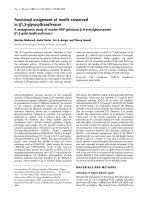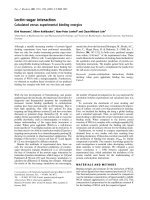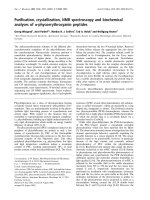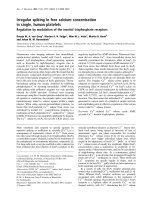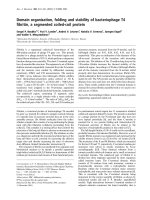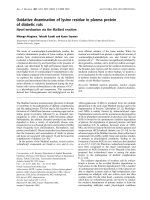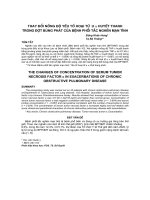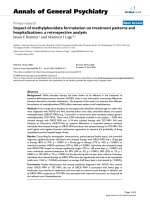Báo cáo y học: "Salmeterol plus fluticasone propionate versus fluticasone propionate plus montelukast: a randomised controlled trial investigating the effects on airway inflammation in asthma" pot
Bạn đang xem bản rút gọn của tài liệu. Xem và tải ngay bản đầy đủ của tài liệu tại đây (321.58 KB, 7 trang )
BioMed Central
Page 1 of 7
(page number not for citation purposes)
Respiratory Research
Open Access
Research
Salmeterol plus fluticasone propionate versus fluticasone
propionate plus montelukast: a randomised controlled trial
investigating the effects on airway inflammation in asthma
Ian Pavord*
1
, Ashley Woodcock
2
, Debbie Parker
1
, Leanne Rice
3
for the
SOLTA study group
Address:
1
Glenfield Hospital, Leicester, UK,
2
Wythenshawe Hospital, Manchester, UK and
3
GlaxoSmithKline UK, Uxbridge, UK
Email: Ian Pavord* - ; Ashley Woodcock - ; Debbie Parker - ;
Leanne Rice -
* Corresponding author
Abstract
Background: Few studies have compared treatment strategies in patients with asthma poorly
controlled on low dose inhaled corticosteroids, and little is known about the effects of different
treatments on airway inflammation. In this double-blind, placebo-controlled, parallel group study,
we compared the effects of salmeterol plus fluticasone propionate (FP) (Seretide™; SFC) and FP
plus montelukast (FP/M) on sputum inflammatory markers, airway responsiveness, lung function,
and symptoms in adult asthmatics.
Methods: Sixty-six subjects were randomised to SFC or FP/M for 12 weeks. The primary outcome
was changes in neutrophil, eosinophil, macrophage, lymphocyte, and epithelial cell levels in induced
sputum. Additional outcomes included the change in other sputum markers of airway inflammation,
airway responsiveness, symptom control, and lung function.
Results: Both treatments had no significant effect on induced sputum inflammatory cells, although
there was a trend for a reduction in sputum eosinophils. Both treatments significantly improved
airway responsiveness, whereas SFC generally led to greater improvements in symptom control
and lung function than FP/M. FP/M led to significantly greater reductions in sputum cysteinyl
leukotrienes than SFC (treatment ratio 1.80; 95% CI 1.09, 2.94).
Conclusion: Both treatments led to similar control of eosinophilic airway inflammation, although
PEF and symptom control were better with SFC.
Study number: SAM40030 (SOLTA)
Background
Asthma is a complex disorder characterised by airway
hyperresponsiveness and variable airflow obstruction in
association with eosinophilic airway inflammation [1].
Treatment with an inhaled corticosteroid (ICS) is usually
the first line of therapy [1]. For patients whose asthma is
poorly controlled on ICS therapy alone, current manage-
ment guidelines recommend add-on therapy with a long-
acting β
2
-agonist, or alternatively a leukotriene receptor
antagonist [2,3]. A recent Cochrane systematic review of
Published: 27 September 2007
Respiratory Research 2007, 8:67 doi:10.1186/1465-9921-8-67
Received: 27 November 2006
Accepted: 27 September 2007
This article is available from: />© 2007 Pavord et al; licensee BioMed Central Ltd.
This is an Open Access article distributed under the terms of the Creative Commons Attribution License ( />),
which permits unrestricted use, distribution, and reproduction in any medium, provided the original work is properly cited.
Respiratory Research 2007, 8:67 />Page 2 of 7
(page number not for citation purposes)
eight randomised controlled trials has shown that the
addition of a long-acting β
2
-agonist (salmeterol or for-
moterol) to existing ICS therapy leads to more effective
asthma control than addition of a leukotriene receptor
antagonist (montelukast or zafirlukast) [4]. The combina-
tion of a long-acting β
2
agonist and an ICS led to signifi-
cant reductions in the risk of exacerbations, night
awakenings, and rescue medication use, and significant
improvements in lung function, symptoms, and quality of
life [4].
The exact relationship between the underlying inflamma-
tory processes and the clinical expression of asthma is
complex and not fully understood. Cross-sectional studies
have shown only a weak correlation at best between the
severity of airway inflammation, measured by inflamma-
tory cell counts or nitric oxide exhalation, and airway
hyper-responsiveness, severity of symptoms, or abnor-
malities in lung function [5-7]. There is limited informa-
tion on the effects of long-acting β
2
-agonists and
leukotriene receptor antagonists on eosinophilic airway
inflammation in asthma. A better understanding of these
effects might inform our understanding of the relation-
ship between inflammation and the clinical expression of
asthma. The objective of this study was to compare the
effects of the combination of salmeterol and the ICS fluti-
casone propionate (FP) (Seretide™; SFC) versus adding
montelukast to FP therapy (FP/M) on airway inflamma-
tory markers, and to relate these effects to changes in air-
way responsiveness, lung function, and symptom control.
Methods
Study population
Asthma patients aged 18–50 years, who were non-smok-
ers and receiving a stable dose of up to 400 µg of beclom-
etasone dipropionate (BDP) a day or equivalent ICS, but
requiring further therapy, were recruited. Additional
inclusion criteria included likelihood of compliance with
the protocol requirements and ability, following instruc-
tion, to use an Accuhaler and mini-Wright peak flow
meter. The criteria for randomisation were: a baseline
forced expiratory volume in 1 second (FEV
1
) of 61–85%
of the predicted normal value; and a PC
20
< 8 mg/ml with
methacholine challenge. In addition, all patients had to
have at least one of the following: diary card recording of
symptoms (score of one or more for day and night com-
bined) on ≥ 4 of the last seven days of the run-in period;
recorded use of relief medication (inhaled Ventolin) on ≥
2 different days during the last seven days of the run-in
period; and a period variation in peak expiratory flow
(PEF) of ≥ 10% over the last seven days of the run in
period. Patients who did not meet the latter three criteria
were able to repeat the run-in period once more. Patients
who fulfilled any of the following exclusion criteria did
not take part in the study: were taking or had previously
taken additional asthma medication, other than an ICS or
short acting β
2
-agonist or oral corticosteroids in the last
three months; acute respiratory infection or exacerbation
of asthma within four weeks of screening, any additional
underlying lung disease, or any significant disease war-
ranting exclusion; hospitalisation or emergency treatment
(for > 24 hours) for acute asthma in the last 12 months;
were a smoker, had smoked in the last six months, or had
a smoking history of 10 pack years or more; pregnant or
lactating women, or women of child-bearing potential
not using adequate contraception; evidence of alcohol,
drug, or solvent abuse; hypersensitivity to any component
of the study formulations, or taking medication contrain-
dicated in combination with the study formulations; and
previous entry to the study or receipt of any investiga-
tional drugs within four weeks of screening.
The study was approved by the ethics committee appro-
priate to each centre before any subjects were enrolled at
that centre, and was conducted in accordance with the
Declaration of Helsinki. All subjects gave written
informed consent before entering the study. The study ran
from May 2001 to August 2002.
Study design and treatments
This was a multicentre, randomised, double-blind, single-
dummy, parallel group study comparing SFC with FP/M.
After an initial screening visit, subjects participated in a 2-
week run-in period to determine eligibility for randomisa-
tion based on a number of pre-specified criteria. During
the run-in period, subjects continued to take their normal
dose of ICS and recorded details of symptoms and relief
medication use on diary cards. During the treatment
period, subjects discontinued their normal asthma medi-
cation and were consecutively randomised according to a
pre-defined randomisation list to either Seretide 50 (Glax-
oSmithKline; salmeterol 25 µg/FP 50 µg) metered dose
inhaler (MDI) two puffs twice daily (bd) (SFC) plus a pla-
cebo to montelukast once daily (od) at night or FP 50 µg
MDI (Flixotide™, GlaxoSmithKline) two puffs bd plus
montelukast 10 mg od at night (FP/M) for 12 weeks, with
an interim clinic visit at six weeks. Treatment allocation
was concealed from the subject, pharmacist, and investi-
gator.
Outcome measures
The primary outcome measure was the levels of inflam-
matory cells (neutrophils, eosinophils, macrophages, and
lymphocytes) and epithelial cells in induced sputum. Sec-
ondary outcome measures were the levels of the inflam-
matory markers cysteinyl leukotrienes (C-LT), histamine,
and interleukin-8 (IL-8) in induced sputum, bronchial
responsiveness to methacholine, the percentages of symp-
tom-free days and nights, the percentages of rescue medi-
cation-free days and nights, and lung function
Respiratory Research 2007, 8:67 />Page 3 of 7
(page number not for citation purposes)
measurements (FEV
1
measured by spirometer and patient
assessed morning and evening PEF). The safety outcome
measure was adverse events (AEs).
Induced sputum collection and analysis
Subjects inhaled increasing concentrations (3%, 4%, 5%)
of 5 ml nebulised pyrogen-free hypertonic saline, and
after each inhalation were encouraged to cough sputum
into a plastic container [8]. If FEV
1
fell by > 10% or 200 ml
but < 20% or 400 ml during the initial inhalation, then
3% saline was used for the second and third inhalations.
If FEV
1
fell by > 20% or 400 ml or significant symptoms
developed, nebulisation was stopped and the subject was
treated with a short-acting β
2
-agonist. The sputum sam-
ples were analysed for the following inflammatory mark-
ers: neutrophils; eosinophils; lymphocytes; epithelial
cells; histamine, as a marker of mast cell activation; C-LT,
as a marker of mast cell and eosinophil activation; and IL-
8, as a marker of neutrophil activation. Sputum IL-8, C-LT
and histamine were measured using standard ELISA kits
(BD Pharmagen, Immunotech and Cayman chemicals
respectively). These assays have been previously validated
for use in sputum supernatants [8]. The sensitivity levels
of the assay were 13 × 10
-3
, 0.8 × 10
-3
, 50 × 10
-3
ng/ml for
C-LTs, IL-8 and histamine. The intra-assay coefficient of
variability was 5–10% and the interassay coefficient of
variability 3–15% across a range of concentrations of
mediators measured.
Methacholine challenge
After measurement of baseline FEV
1
, subjects were admin-
istered doubling doses of methacholine chloride (0.025–
25 mg/ml; manufacturer: methapharm inc) every five
minutes followed by measurement of FEV
1
. The proce-
dure was continued until FEV
1
fell by ≥ 20% or until the
highest concentration of methacholine chloride was
reached. The cumulative provocation concentration of
methacholine causing a 20% reduction in FEV
1
(PC
20
)
was determined by linear interpolation between log con-
centrations enclosing a 20% reduction in FEV
1
. The
change in methacholine PC
20
was expressed in doubling
concentrations calculated for each subject using the fol-
lowing formula:
(log
10
PC
20
end of treatment - log
10
PC
20
baseline)/
log
10
(2)
Statistical methods
As this was an exploratory study, no formal sample size
calculation was carried out: sample size was, therefore,
limited by subject availability.
All summaries and analyses are for the intention-to-treat
population (all subjects receiving at least one dose of the
study drug). No imputations were performed for missing
data. Therefore if data were missing for either baseline or
one of the timepoints, it was not possible to calculate a
change from baseline. However, all available data have
been used for relevant summaries. The change from base-
line in levels of the primary inflammatory markers and IL-
8 was analysed within each treatment group using the Wil-
coxon signed rank test, owing to the non-normality of the
data. Between group comparisons for the primary inflam-
matory markers, IL-8, symptom-free days and nights, and
rescue-free days and nights were analysed using the van
Elteren extension to the Wilcoxon rank sum test, adjusting
for baseline values. The confidence interval (CI) was cal-
culated using the Hodges-Lehmann method, ignoring the
adjustment for baseline and pooling all treatment differ-
ences.
The results of analyses with log transformed values (C-LT
and histamine) and log
10
transformed PC
20
values are
back transformed and presented as ratios of geometric
means or doubling dose changes rather than log differ-
ences. The ratio of SFC to FP/M was also calculated and is
referred to as the treatment ratio. Within and between
group differences were analysed using the paired t-test and
analysis of covariance (ANCOVA) adjusting for baseline
values, respectively. Between treatment comparisons for
change in FEV
1
and morning and evening PEF were also
analysed using ANCOVA, adjusting for baseline values,
age, sex, and height. Age, sex and height were adjusted for
in these analyses to balance out differences expected. All
statistical tests were two-sided and significance was
accepted at the 5% level.
Results
Demographic and baseline characteristics
Of the 132 subjects enrolled into the study, 66 were ran-
domised to treatment, 33 in each treatment group. The
flow of subjects through the study is shown in Figure 1.
"Other" reasons for withdrawal from the treatment period
in the SFC arm were: did not attend for a visit (2 subjects);
failed Methacholine challenge (2 subjects); sputum sam-
ple inadequate (1 subject); study medication discarded in
error (1 subject). The treatment groups were well matched
for baseline characteristics (Table 1). Sixty-five subjects
(98%) were taking an ICS on entry to the study, which was
BDP in the majority of cases (62/65; 95%).
Induced sputum inflammatory markers
Satisfactory sputum samples were obtained at baseline
from 79% (26/33) of subjects randomised to SFC and
82% (27/33) of subjects randomised to FP/M. At end of
treatment these percentages were 52% SFC (17/33) and
58% FP/M (19/33). The percentage of eosinophils
decreased relative to baseline in each treatment group
with no significant difference between treatment groups
(Table 2 and Figure 2). There was a slight trend for the
Respiratory Research 2007, 8:67 />Page 4 of 7
(page number not for citation purposes)
sputum neutrophil count to decrease with SFC although
the change was not significantly different from that seen
with FP/M (mean difference in change in neutrophil dif-
ferential count [SFC – FP/M] -9.4%; 95% CI -26.5%,
6.40%; p = 0.13; Table 2 and Figure 3). There were no
other statistically significant changes in sputum cell
counts (Table 2).
The mean levels of C-LT and histamine decreased in both
treatment groups relative to baseline, although a signifi-
cant treatment effect was only seen for C-LT in the FP/M
group (treatment ratio for C-LT 1.80; 95% CI 1.09, 2.94;
p = 0.021; Table 3). Neither treatment had a significant
effect on the median IL-8 concentration (Table 3).
Airway responsiveness
Geometric mean PC
20
significantly increased from 0.28 to
1.02 mg/ml (mean difference 1.74 doubling doses; 95%
CI 0.96 doubling doses to 2.52 doubling doses) with SFC
and from 0.32 to 1.10 mg/ml with FP/M (mean difference
1.98 doubling doses; 95% CI 0.93 doubling doses to 3.03
doubling doses); there was little difference between treat-
ments (treatment ratio 0.91; 95% CI 0.46, 1.78; p = 0.77).
Lung function
There was a non-significant trend towards a greater
increase from baseline in FEV
1
with SFC compared with
FP/M. Increases in both mean morning and evening PEF
were significantly greater after SFC treatment compared
with FP/M (Table 4).
Symptoms
There was a trend for greater improvements in symptom
scores with SFC compared with FP/M. The median per-
centage of symptom-free days increased from 14% to 71%
and from 29% to 67% after SFC and FP/M treatment,
respectively (mean difference in change 13.2%, 95% CI -
1.9%, 32.9%, p = 0.064). Similarly, for symptom-free
nights, there was an increase from 52% to 89% in the SFC-
treated group and from 57% to 82% in the FP/M-treated
group (mean difference in change 13.3%; 95% CI -1.5%,
34.5%; p = 0.055). SFC also led to greater increases from
baseline in median rescue medication-free days (14% to
73% versus 29% to 70%) and nights (50% to 93% versus
71% to 82%) compared with FP/M, although, after adjust-
ing for baseline values, the treatment effect was only sig-
nificant for rescue-free nights (treatment difference
16.5%; 95% CI 1.4%, 36.1%; p = 0.01).
Safety: adverse events
There was no difference in the incidence of AEs between
the SFC-and FP/M-treated groups (31 AEs in 19 subjects
versus 31 AEs in 21 subjects) and AEs most commonly
affected the ear, nose, and throat, lower respiratory and
gastrointestinal body systems. Three AEs in three subjects
in the SFC-treated group and eight AEs in five subjects in
the FP/M-treated group were considered to be causally
related to treatment. Two subjects, both treated with SFC,
Flow of subjects through the studyFigure 1
Flow of subjects through the study. FP, fluticasone pro-
pionate; n, number
Table 1: Demographic and baseline characteristics
SFC (n = 33) FP/M (n = 33)
Mean age in years (SD) 36.3 (8.11) 34.4 (7.71)
No of females (%) 18 (55%) 14 (42%)
Mean duration of asthma in years (SD) 21.1 (12.7) 18.4 (9.7)
Mean AM PEF (L/min) (SD) 412 (95) 422 (103)
Mean % predicted mean AM PEF (SD) 84 (12) 83 (14)
Mean clinic FEV
1
(L) (SD) 2.65 (0.77) 2.76 (0.60)
% predicted clinic FEV
1
(SD) 75 (9) 76 (7)
Geometric mean PC
20
(mg/ml) 0.28 0.32
Median dose of pre-study ICS (BDP equivalent)
(mcg) (range)
400 (200 to 400) 400 (100 to 400)
AM, morning; FEV
1
, forced expiratory volume in 1 second; FP/M, fluticasone propionate plus montelukast; n, number; PEF, peak expiratory flow;
SD, standard deviation; SFC, salmeterol plus fluticasone propionate
Respiratory Research 2007, 8:67 />Page 5 of 7
(page number not for citation purposes)
reported serious adverse events (pituitary tumour; haema-
turia), neither of which were assessed as being related to
the study drugs. There were no deaths during the study.
Discussion
This study compared the effects of treatment with a com-
bination of an ICS (FP) with either a long-acting β
2
-ago-
nist (salmeterol) or a leukotriene receptor antagonist
(montelukast) on markers of airway inflammation, lung
function, and symptom control in patients with poorly
controlled asthma. The results are based on a small
exploratory study and should be considered as hypothe-
sis-generating rather than definitive.
The primary outcome was the extent of airway inflamma-
tion as determined by the levels of inflammatory cells in
sputum. We chose to analyse induced sputum samples as
opposed to bronchoalveolar lavage (BAL) or bronchial
biopsy as the procedure is less invasive and has been
shown to be more sensitive for detecting changes in mark-
ers of airway inflammation [9]. We found that sputum
eosinophil counts were generally low in those patients
with symptomatic asthma already established on treat-
ment with a low or moderate dose ICS. Neither treatment
combination led to significant changes from baseline in
the primary inflammatory markers. Recent studies suggest
reduction in peripheral blood eosinophil counts with the
addition of montelukast to ICS therapy in patients with
poorly controlled asthma [10-13]. The lack of effect on
sputum eosinophils might reflect the low baseline levels.
We did see a significantly greater reduction in the concen-
tration of C-LT with FP/M compared with SFC. Montelu-
kast has no known effect on leukotriene biosynthesis so
an effect on C-LT concentrations would not be antici-
pated. Perhaps montelukast reduces the activation status
of inflammatory cells producing C-LT. Neither treatment
combination had any effect on the concentration of other
inflammatory mediators.
A notable finding of the current study is that most patients
with symptomatic asthma despite treatment with low
dose ICS had no sputum evidence of eosinophilic airway
inflammation. Moreover, the improvement in symptoms,
airway responsiveness, and lung function seen with addi-
tional salmeterol, and to a lesser extent montelukast, was
not associated with any change in the sputum eosinophil
count. These observations provide further support for the
view that the mechanisms that cause symptoms and
abnormal airway function can be disassociated from eosi-
nophilic airway inflammation [5-7]. The residual symp-
toms and abnormal airway function seen in our patients
in the absence of eosinophilic airway inflammation could
reflect the effect of permanent structural changes due to
airway remodelling, although the beneficial effects of
long-acting β
2
-agonists seen in this and other studies [4]
suggest that they are, at least partly, due to the presence of
a corticosteroid resistant, β
2
-agonist responsive abnormal-
ity of airway function.
Generally, SFC treatment led to better symptom control
and improved lung function than the FP/M combination,
Neutrophil count in induced sputum before and after treat-mentFigure 3
Neutrophil count in induced sputum before and after
treatment. The box is determined by the first and third
quartile and the whiskers are determined by the maximum
and minimum. The horizontal line represents the median
value. SFC, salmeterol plus fluticasone propionate; FP/M, flu-
ticasone propionate plus montelukast.
Eosinophil count in induced sputum before and after treat-mentFigure 2
Eosinophil count in induced sputum before and after
treatment. The box is determined by the first and third
quartile and the whiskers are determined by the maximum
and minimum. The horizontal line represents the median
value. SFC, salmeterol plus fluticasone propionate; FP/M, flu-
ticasone propionate plus montelukast
Respiratory Research 2007, 8:67 />Page 6 of 7
(page number not for citation purposes)
Table 3: Ratio of mean endpoint to baseline levels for cysteinyl leukotrienes and histamine
Marker SFC (n = 33) FP/M (n = 33) Treatment ratio (95% CI)
Baseline Ratio* (95% CI) Baseline Ratio* (95% CI)
C-LT (ng/ml) 1.14 0.97 (0.68, 1.37) 0.91 0.54
†
(0.38, 0.77) 1.80 (1.09, 2.94)
‡
Histamine (ng/ml) 5.10 0.65 (0.36, 1.18) 5.16 0.95 (0.52, 1.73) 0.69 (0.30, 1.62)
* ratio of endpoint value to baseline value, adjusted for baseline values; † within-group ratio p = 0.005; ‡ between group p = 0.021
CI, confidence interval; FP/M, fluticasone propionate plus montelukast; n, number; SFC, salmeterol plus fluticasone propionate
Table 2: Change from baseline in levels of airway inflammatory markers
Marker SFC (n = 33) FP/M (n = 33) Treatment difference
(95% CI)
Baseline Change* (95% CI) Baseline Change* (95% CI)
Primary markers (median)
Neutrophils (%) 37.40 -2.30 (-16.80, 14.70) 28.00 3.00 (-7.20, 15.50) -9.40 (-26.50, 6.40)
Eosinophils (%) 1.20 -0.50 (-2.80, 0.80) 1.00 -0.50 (-1.00, 0.00) 0.20 (-1.50, 1.50)
Lymphocytes (%) 0.00 0.00 (-0.30, 0.50) 0.00 0.00 (0.00, 0.00) 0.00 (-0.30, 0.50)
Macrophages (%) 45.40 4.00 (-10.70, 15.20) 64.00 -0.50 (-8.70, 10.80) 1.70 (-12.60, 17.20)
Epithelial cells (%) 3.40 0.00 (-4.30, 8.00) 6.00 0.00 (-3.50, 2.50) 2.20 (-2.80, 9.00)
Secondary marker (median)
IL-8 (ng/ml) 3.80 0.00 (-0.29, 5.55) 2.99 0.00 (-5.32, 1.11) 3.85 (-0.32, 8.08)
* median change from baseline
CI, confidence interval; FP/M, fluticasone propionate plus montelukast; n, number; SFC, salmeterol plus fluticasone propionate
Table 4: Mean change from baseline in FEV
1
, and morning and evening PEF after treatment
Variable SFC (n = 33) FP/M (n = 33) True treatment difference (95% CI)
Baseline
(mean)
Change*
(mean (95% CI))
Baseline
(mean)
Change*
(mean (95% CI))
FEV
1
(L) 2.65 0.41 (0.27, 0.56) 2.76 0.30 (0.16, 0.44) 0.11 (-0.10, 0.32)
Mean Morning PEF (L/min) 411.8 61.9 (48.3, 75.6) 421.5 28.7 (14.7, 42.6) 33.3 (13.6, 52.9)
†
Mean Evening PEF (L/min) 438.8 41.7 (28.3, 55.1) 439.3 19.0 (5.3, 32.7) 22.7 (3.4, 42.1)
‡
* adjusted mean change from baseline, adjusted for baseline values, age, sex, and height; † between group p = 0.001; ‡ between group p = 0.022
CI, confidence interval; FEV
1
, forced expiratory volume in 1 second; FP/M, fluticasone propionate plus montelukast; n, number; PEF, peak
expiratory flow; SFC, salmeterol plus fluticasone propionate
Respiratory Research 2007, 8:67 />Page 7 of 7
(page number not for citation purposes)
with significantly more rescue medication-free nights and
greater increases relative to baseline in morning and
evening PEF. These results are consistent with the results
of the Cochrane review, which suggested superiority for
the long-acting β2-agonist and ICS combination over the
combination of a leukotriene receptor antagonist and an
ICS, with significantly greater improvements in lung func-
tion, symptom control, and quality of life [4]. The find-
ings of the current study are important in that they suggest
that the beneficial effects of long-acting β2-agonist and
ICS combination over the combination of a leukotriene
receptor antagonist and an ICS are also seen in a popula-
tion who do not have to meet inclusion criteria which
include a large acute bronchodilator response. There has
been concern that the greater suppression of clinical
expression of asthma seen with long acting β2-agonists
might be associated with masking of eosinophilic airway
inflammation and perhaps a higher risk of serious exacer-
bations and/or airway remodelling [14]. Our findings
clearly indicate that, when given in the form of a combi-
nation inhaler, there is no evidence of worsening airway
inflammation when salmeterol is added to low dose ICS.
Conclusion
When added to low dose inhaled FP, neither salmeterol
nor montelukast were associated with significant changes
in sputum inflammatory cells. The addition of salmeterol
to FP produced significantly better symptom control and
PEF than the addition of montelukast.
Competing interests
IP has received payments for lectures and for attending
scientific conferences from GSK and Astra Zeneca. He has
received an unrestricted research grant of €250,000 from
GSK. AW has been reimbursed for chairing and speaking
at scientific meetings and has served on advisory boards
for GSK, Chiesi, Schering Plough and Novartis. He has
received research grants and is a principal investigator on
GSK studies. DP has no competing interests. LR is an
employee of GSK.
Authors' contributions
IP was involved in the design of the study and the inter-
pretation of the results, as well as reviewing the manu-
script. AW was involved in the conduct of the study, the
interpretation of the results and the reviewing of the man-
uscript. DP was involved in eth analysis of the laboratory
samples and the reviewing of the manuscript. LR was
involved in the design and statistical analysis of the study
as well as coordinating and reviewing the manuscript. All
authors read and approved the final manuscript.
Acknowledgements
We would like to thank Dr Helen Wiggett of Dianthus Medical Limited
who provided medical writing services on behalf of GlaxoSmithKline UK
Limited.
The other members of the SOLTA study group were: Dr Corrigan, Lon-
don; Professor Corris, Newcastle-upon-Tyne; Dr Harrison, Swansea; Pro-
fessor Knox, Nottingham; and Dr Millar, Bristol.
Funding for this study was provided by GlaxoSmithKline UK (protocol
SAM40030). As the sponsor of the study, GlaxoSmithKline UK was respon-
sible for all aspects of the study, including design, data collection and inter-
pretation, and reporting. Written consent was obtained from the subjects.
References
1. Barnes PJ: The role of inflammation and anti-inflammatory
medication in asthma. Respir Med 2002, 96(Suppl A):S9-15.
2. Global Initiative for Asthma. Global strategy for asthma
management and prevention. NHLBI/WHO Workshop
Report. NIH Publication number 02-3659 2002 [http://
www.ginasthma.org]. updated 2004. Date last accessed: February 10
2005
3. British Thoracic Society and Scottish Intercollegiate Guide-
lines network. British guidelines on the management of
asthma 2004 [
]. Date last accessed:February
10 2005
4. Ram F, Cates C, Ducharme F: Long-acting β
2
-agonists versus
anti-leukotrienes as add-on therapy to inhaled corticoster-
oids for chronic asthma. Cochrane Database Syst Rev
2005:CD003137.
5. Chapman ID, Foster A, Morley J: The relationship between
inflammation and hyperreactivity of the airways in asthma.
Clin Exp Allergy 1993, 23(3):168-171.
6. Green RH, Brightling CE, Woltmann G, Parker D, Wardlaw AJ,
Pavord ID: Analysis of induced sputum in adults with asthma:
identification of subgroup with isolated sputum neutrophilia
and poor response to inhaled corticosteroids. Thorax 2002,
57(10):875-879.
7. Wardlaw AJ, Brightling CE, Green R, Woltmann G, Bradding P,
Pavord ID: New insights into the relationship between airway
inflammation and asthma. Clin Sci (Lond) 2002, 103(2):201-211.
8. Birring SS, Parker D, Brightling CE, Bradding P, Wardlaw AJ, Pavord
ID: Induced sputum inflammatory mediator concentrations
in chronic cough. Am J Respir Crit Care Med 2004, 169:15-19.
9. Nocker RE, Out TA, Weller FR, de Riemer MJ, Jansen HM, van der
Zee JS: Induced sputum and bronchoalveolar lavage as tools
for evaluating the effects of inhaled corticosteroids in
patients with asthma. J Lab Clin Med 2000, 136(1):39-49.
10. Bjermer L, Bisgaard H, Bousquet J, Fabbri LM, Greening AP, Haahtela
T, Holgate ST, Picado C, Menten J, Dass SB, Leff JA, Polos PG: Mon-
telukast and fluticasone compared with salmeterol and fluti-
casone in protecting against asthma exacerbation in adults:
one year, double blind, randomised, comparative trial. BMJ
2003, 327:891.
11. Wilson AM, Dempsey OJ, Sims EJ, Lipworth BJ: Evaluation of salm-
eterol or montelukast as second-line therapy for asthma not
controlled with inhaled corticosteroids. Chest 2001,
119(4):1021-1026.
12. Currie GP, Lee DK, Haggart K, Bates CE, Lipworth BJ: Effects of
montelukast on surrogate inflammatory markers in corti-
costeroid-treated patients with asthma. Am J Respir Crit Care
Med 2003, 167:1232-1238.
13. Ilowite J, Webb R, Friedman B, Kerwin E, Bird SR, Hustad CM, Edel-
man JM: Addition of montelukast or salmeterol to fluticasone
for protection against asthma attacks : a randomized, dou-
ble-blind, multicenter study. Ann Allergy Asthma Immunol 2004,
92(6):641-648.
14. Mcivor RA, Pizzichini E, Turner MO, Hussack P, Hargreave FE, Sears
MR: Potential masking effects of salmeterol on airway inflam-
mation in asthma. Am J Respir Crit Care Med 1998, 158:924-30.

